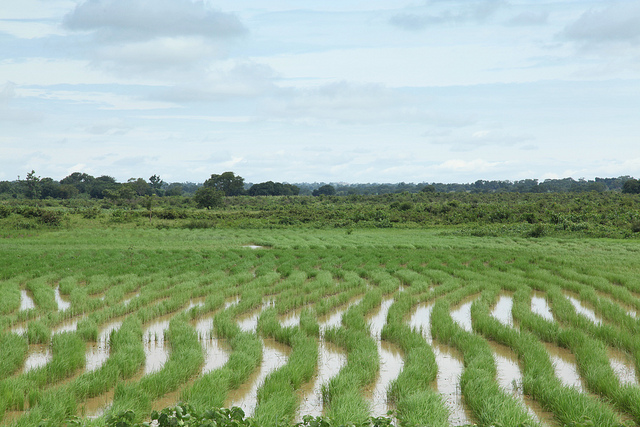
Rice field in Niger county
The environmental/ecological impact of food losses are starting to gain more attention in the general food loss and waste arena. Reports from the FAO (2013 & 2015) and from scholars like Kummu et al. (2012) highlight the environmental impact of food loss and waste in terms of greenhouse gas (GHG) emissions, water usage, fertiliser usage, biodiversity loss and land occupation. These studies revealed the effects of producing food that ultimately goes uneaten are profound and extensive. For instance, food loss accounts for 4.4 gigatonnes CO2 equivalent GHG emissions (FAO, 2015). If food loss and waste were a country, only China and the USA would be larger emitters. Selina Juul (2012) emphasises the link between waste and GHGs in her very informative TEDx talk (available to watch in the video section).
The environmental impact of food loss is laid bare in a study by GIZ (2014). This publication involved an analysis of the rice supply chain from cradle to shelf in Nigeria. Data were collected in two counties; Niger and Kogi. The data were then extrapolated to form an informed estimate for the whole of Nigeria. The statistics reveal the significant impact that losses have.
In total, 24.9% of the crop was lost from cradle to shelf. Hotspots for losses were harvesting, threshing, parboiling and milling. These losses represent 0.65 million tonnes of CO2 equivalent per annum. According to the authors, this equates to the emissions of more than one million Nigerians. Furthermore, if losses of rice were halved then it would have the same effect as taking 215,000 cars off the roads for a year. In terms of water use, rice losses in Nigeria represent a water stress footprint of 2.1 million m³. This amount of water could potentially have served 110,000 people, although the authors point out that water is not an environmental hotspot in the rice value chain in Nigeria. In terms of land usage, 0.5 million ha were used to cultivate rice that went unconsumed. This represents 19 per cent of the total area assigned to rice production.
The results of the study clearly indicate that reducing rice losses in Nigeria would have multiple benefits, chief among them an increase in food security in this Sub Saharan African country. Studies like these offer fascinating insights into the impact that food losses in individual countries can have.
Further Reading:
GIZ (2014). Post-Harvest Losses of Rice in Nigeria and their Ecological Footprint, December. Available at: https://www.giz.de/fachexpertise/downloads/giz2014-en-post-harvest-losses-of-rice-in-nigeria-and-their-ecological-footprint.pdf
